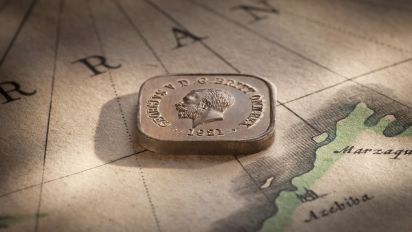1921 Kookbaurra Square Penny design type 11



For the buyer contemplating a Square Penny purchase, three considerations should be foremost.
The first is the quality. The Square Pennies were test pieces and were not struck under the heady controls of a proof striking. It is also noted that as the coins were passed to the public for opinions and comments, many have been mishandled.
Our comments are as follows.
As described above, this coin is superb for quality. In fact, we checked back through our records and can confirm that we have only ever sold five Choice Uncirculated Type 11s in more than 40-plus years of trading and this coin is one of the five.
The second consideration is the design type. The style of the kookaburra and the style of lettering is critical to assessing the rarity of the coin for while all Square Pennies are rare, some designs are far rarer than others.
Our comments are as follows.
The Melbourne Mint tested two different kookaburra designs in 1921, one featuring a sleek kookaburra sitting on a twig, known as the Type 11. The other a plump bird resting on a branch, known as the Type 12.
The Type 11 Square Pennies are extremely scarce. You would be lucky to sight one coin at auction annually. So if there is a choice between the two, the Type 11 wins hands down every time.
The third consideration is the price. Given its quality assignation of Choice Uncirculated and its rarity, the 1921 Type 11 Square Penny is priced to market at $35,000.
Our comments are as follows.
The Type 11 Kookaburra Penny is being offered at the same price as a circulated 1930 Penny and is far, far scarcer.
In our view, this 1921 Square Penny is the perfect starting point for the buyer keen to acquire a Kookaburra Penny. Optimum quality, extreme rarity but at a price that is attractive.
That currency reflects the mood of a nation – and the agenda of a Government - is never more evident than with the Square Penny and Halfpenny series and its mooted introduction in 1919.
The proposed change was pure politics. With some saying it was the rumblings of a republican movement way ahead of its time, the Labor Government wanting to break away from the traditional British designs of Australia’s then copper penny and halfpenny.
A wave of nationalism was sweeping the country post World War I and the Government saw advantage in tapping into the mood of the nation and introducing a uniquely Australian style into our currency by depicting a laughing kookaburra on our coinage.
Tests commenced at the Melbourne Mint in 1919 and continued until 1921 with the test pieces ultimately passed to dignitaries and Government officials to assess their reaction.
The extreme scarcity of choice quality Square Pennies is connected to the fact that the coins were test pieces and were not struck to the exacting standards of proof coining.
Given to dignitaries to assess their reaction, there was no packaging and we know that not every dignitary was a collector and would have handled them with care. Some of the coins must have been tucked into a fob pocket for they have circulated. Others could have rattled around a top desk drawer. Or passed around to colleagues … introducing multi possibilities of mishandling.
Public reaction to the introduction of the square coinage was poor. There was widespread public resistance to change, while the elderly rejected the small size of the coins. However, the final decision not to proceed seems to have been based mainly on another consideration – the large number of vending machines then in operation requiring a circular coin.
The kookaburra coins never went into production and Australia lost a great opportunity to go its own way.
But with only the 200 prototypes to show as evidence of the Government’s grand scheme, Australian coinage gained another wonderful coin rarity.
© Copyright: Coinworks